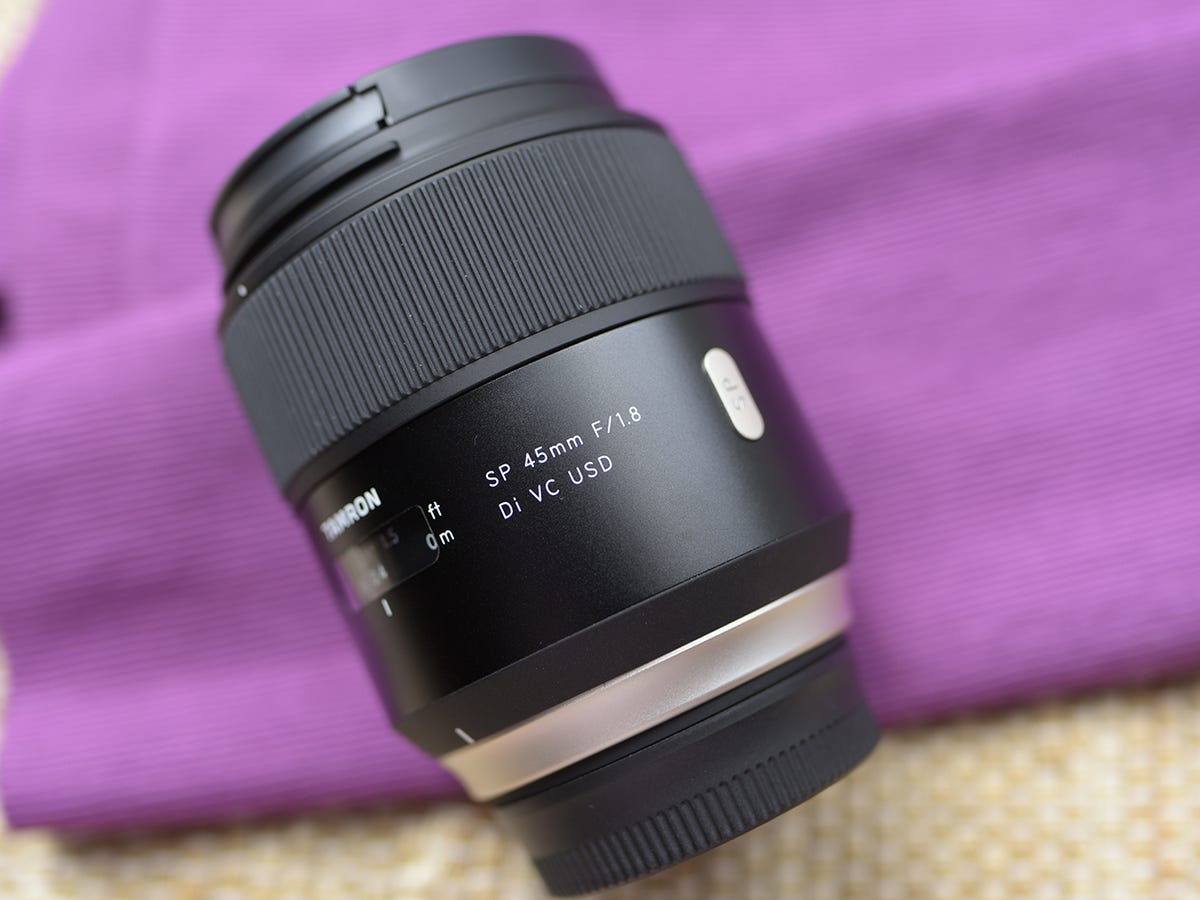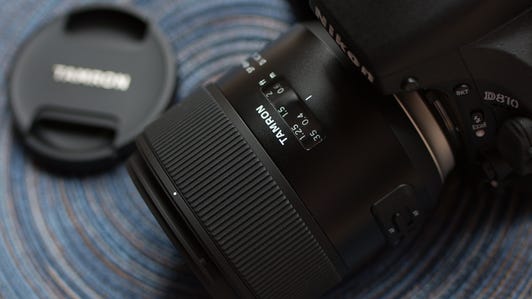
The Tamron SP 45mm f1.8 Di VC USD lens.
Lori Grunin/CNET
Tamron is known for its affordable lenses that are never quite the first choice, but that are frequently worth the compromises given the price. The company is hoping to change that perception with its redesigned SP (Superior Performance) series of lenses, starting with a couple of fast single focal-length lenses — the SP 35mm f1.8 Di VC USD and the SP 45mm f1.8 Di VC USD — Tamron’s first non-macro primes.
While the lenses are designed for full-frame cameras, they bear an APS-C-friendly price of $600 (directly converted about £390, AU$850), an aggressive decision given their features and design. That’s intentional, since the best way to upgrade the quality of your APS-C dSLR is to dump the kit lens and attach a better, wide aperture one.
However, even paired with a full-frame, high-resolution camera like the Nikon D810 it resolved detail well, at least based on the short time I had to try it.
Tamron’s new fast primes: Affordable but not cheap (pictures and photo samples)






The two very similar lenses launch Tamron’s updated SP series with a more modern design, better build quality and better optical formula than we’ve seen before from the company. (Type geeks will also notice the new, modernized logo face on the lens cap.)
Following in Sigma’s aesthetic footsteps, they have smoothly finished metal barrels, a wide rubberized grip for manual focus, an “SP” badge declaring the brand and big and easy-to-manipulate vertical switches for focus and image stabilization.
Yes, you read that right: image stabilization. Huzzah! Most fixed-focal-length lenses only have it for telephoto models; the sole exception I could find is Canon’s similarly priced 35mm f2. Lack of stabilization is my biggest complaint with Sigma’s offerings.
In fact, if it weren’t for the big gold band around the end, you might be forgiven for confusing it with one of Sigma’s current lenses. And that’s a good thing. They feel sturdy, with a nicely damped manual-focus ring that allows for smooth, precise focus. Both have pretty close minimum-focus distances, 20.1 cm/7.9 inches for the 35mm and 29.0 cm/11.4 inches for the 45mm.
They’re moisture resistant, with fluorine coating on the front element to provide water and smudge protection.
They also incorporate Tamron’s eBand and BBAR coatings, its branded versions of nanoparticle coatings that most higher-quality lenses use to reduce artifacts from bright or bouncing light and to promote clarity.
The other alphabet-soup entry in the name is USD for Ultrasonic Silent Drive, Tamron’s branding for its ultrasonic motor, which is used to keep lenses quiet while focusing.
Going with f1.8 (rather than f1.4 or f2.8) was a smart decision; the cost of eking out that fractional stop wider to f1.4 puts you in a completely different price class, as evidenced by Sigma’s more expensive — but great values for that segment — line of f1.4 lenses like its 50mm f1.4 and other fast-prime lenses. For most people, f1.8 is sufficiently wide. It’s actually difficult to focus properly as the aperture widens, which makes f1.8 a good choice for enthusiasts; you don’t end up paying for the extra aperture that you may get frustrated using.
The choice of focal lengths is also interesting. On a full-frame camera, 35mm is a nice landscape angle of view; on an APS-C, it’s equivalent to about 53mm (Nikon) or 56mm (Canon), making it a great angle of view for street shooting.
On the other hand, 45mm is an novel choice. There really are no general purpose 45mm lenses, but I think it makes an excellent option for street shooting on a full-frame body — that little extra wider angle is useful — and on an APS-C Nikon (68mm) or Canon (72mm) it becomes a solid portrait and product-photography lens.
Both lenses are expected to ship by the end of September 2015.
Specifications
| Mount | Canon EF, Nikon FX/DX, Sony FE (future) | |
| Focal range | 35mm | 45mm |
| Aperture range | f1.8 – f16 | f1.8 – f16 |
| Minimum focus distance | 20.1 cm/7.9 inches | 29.0 cm/11.4 inches |
| Angle of view | 63°26′ (full frame)43°29′ (APS-C) | 51°21′ (full frame) 34°28′ (APS-C) |
| Aperture blades | 9 | 9 |
| Elements | 10 elements, 2 molded glass aspherical, 1 low dispersion, 1 extra low dispersion | 10 elements, 2 molded glass aspherical, 1 low dispersion |
| Filter diameter | 67mm | 67mm |
| Length | Canon 3.2 in/81mm; Nikon 3.1 in/79mm | Canon 3.6 in/91mm; Nikon 3.5 in/89mm |
| Diameter | 3.2 in/80.4 mm | 3.2 in/80.4 mm |
| Weight | Canon 16.9 oz/479 g; Nikon 15.9 oz/451 g | Canon 19 oz/539 g; Nikon 18.3 oz/519 |
| Price | $600 | $600 |
| Availablity | September 2015 | September 2015 |




